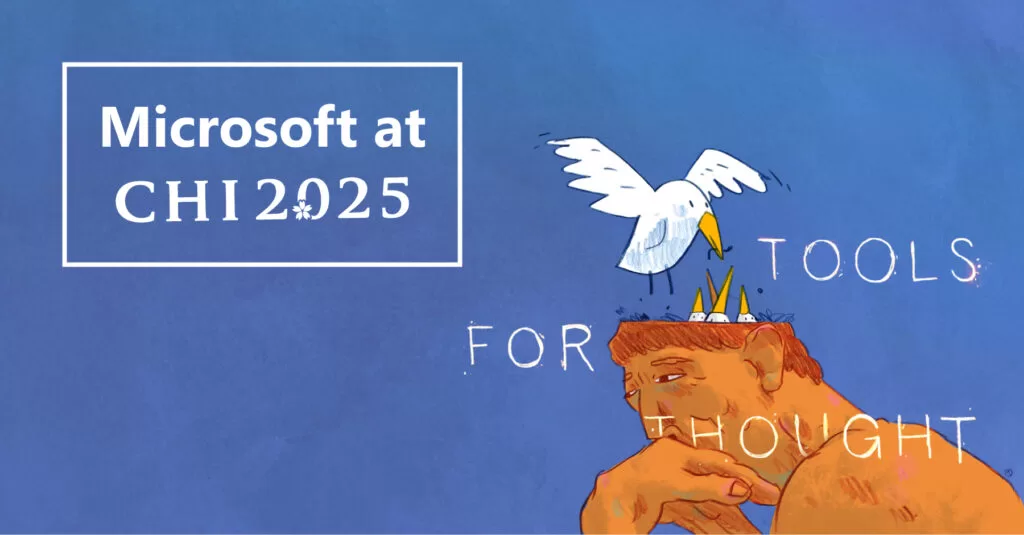
Can AI tools do more than streamline workflows—can they actually help us think better? That’s the driving question behind the Microsoft Research Tools for Thought initiative. At this year’s CHI conference, we’re presenting four new research papers and cohosting a workshop that dives deep into this intersection of AI and human cognition.
This post provides an overview of our latest research, starting with a study on how AI is changing the way we think and work. We also introduce three prototype systems designed to support different cognitive tasks. Finally, through our Tools for Thought workshop, we’re inviting the CHI community to help define AI’s role in supporting human thinking.
AI’s effects on thinking at work
With a single prompt, AI can generate a wide range of outputs, from documents and meeting agendas to answers and automated workflows. But how are people’s thinking processes affected when they delegate these tasks to AI?
One of our goals is to understand how knowledge workers use AI, how they perceive its value, and how it affects cognitive effort.
Our study, “The Impact of Generative AI on Critical Thinking: Self-Reported Reductions in Cognitive Effort and Confidence Effects From a Survey of Knowledge Workers,” surveyed 319 professionals using AI across a variety of occupations. Participants shared 936 real-world AI use cases and reflected on how it influenced their critical thinking and mental effort. We summarize these findings below.
Defining and deploying critical thinking. Knowledge workers describe critical thinking as involving activities like setting clear goals, refining prompts, and verifying AI outputs against external sources and their own expertise. They rely on these practices to maintain work quality when using AI—motivated by the need to avoid errors, produce better results, and develop their skills.
Findings
Balancing cognitive effort. Participants’ reports about critical thinking and the effort involved align with longstanding human tendencies to manage cognitive load at work. For high-stakes tasks requiring accuracy, they say they expend more effort in applying critical thinking with AI than they would performing the same tasks without it. In contrast, during routine, low-stakes tasks under time pressure, they report spending less effort on critical thinking when using AI compared with completing the task without it.
Confidence effects. The study found that higher confidence in AI was associated with less critical thinking, while higher self-confidence in one’s own abilities was associated with more critical thinking—though at a perceived higher cognitive cost. This suggests a delicate balance between using AI for efficiency and maintaining active critical engagement.
Shift in the nature of critical thinking. Participants reported a shift in critical thinking activities, with a greater focus on information verification, response integration, and task stewardship. While AI automates certain aspects of knowledge work, it also demands more effort in evaluating the accuracy and relevance of AI-generated content.
Barriers to critical engagement. The study identified several barriers that inhibit critical thinking when using AI. These include a lack of awareness of the need for critical evaluation, limited motivation due to time pressure or perceived job scope, and difficulty in refining prompts—especially in unfamiliar domains.
Recommendations
To foster critical thinking at work, we recommend that AI tools actively encourage awareness, motivation, and skill development.
AI tools should enhance motivators for critical thinking (e.g., quality standards, skill-building) and mitigate inhibitors (e.g., time constraints, low awareness). Proactive prompts can surface overlooked tasks, while reactive features can offer on-demand assistance. Motivation can be strengthened by positioning critical reflection as part of professional growth—not just extra work.
AI tools should also support knowledge workers’ ability to think critically by providing reasoning explanations (as some newer AI models now do), guided critiques, and cross-references. This shift must occur in both the design of the technology and in the mindsets of knowledge workers. Rather than treating AI as a tool for delivering answers, we suggest treating it as a thought partner—one that can also act as a provocateur.
Beyond these insights, our other CHI papers explore practical ways to design AI that augments human cognition.
Enhancing decision-making with AI
Decision-making is central to knowledge work, and AI is increasingly used to help people make decisions in complex fields like healthcare and finance. However, how much agency do knowledge workers retain when AI is involved?
Our study, “AI, Help Me Think—but for Myself: Exploring How LLMs Can Assist People in Complex Decision-Making by Providing Different Forms of Cognitive Support,” conducted in collaboration with University College London, examines this question. We began with a small formative study involving 10 participants, followed by a comparative study with 21 participants using two different AI-supported decision-making systems.
For a complex financial investment task, we compared two different AI tools (Figure 1): RecommendAI, which provides AI-generated recommendations, and ExtendAI, which encourages users to articulate their reasoning before receiving AI feedback.

Findings
Both systems were found to offer benefits for augmenting cognition and addressing some of the challenges to critical thinking identified in the knowledge worker survey above, suggesting the potential for a balanced approach.
RecommendAI offered concrete suggestions that inspired users to explore new directions in their decision-making. This often led to fresh insights and reflections. However, the recommendations at times felt disconnected from the user’s own reasoning, reducing the depth of engagement.
In contrast, ExtendAI encouraged users to reflect more deeply on their decisions by providing feedback on their reasoning. This helped them examine their thought processes and consider alternative perspectives. However, some users found the feedback too general and not actionable enough.
When it came to how users integrated the tools into their decision-making process, RecommendAI, introduced perspectives that pushed users to think beyond their usual patterns. By recommending options not based on users’ own reasoning, it encouraged exploration of ideas they might not have considered. However, some users perceived the recommendations as a “black box” solution. This lack of transparency made those recommendations harder to understand, trust, and apply to their own thought processes.
ExtendAI, on the other hand, aligned with users’ existing reasoning, making its feedback easier to incorporate. This helped the users maintain a sense of control and continuity. However, because the feedback often echoed their initial thoughts, it sometimes limited new insights and risked reinforcing existing biases.
These findings suggest that AI tools like ExtendAI, designed to elicit and build on users’ own cognitive processes, may offer a more effective approach to augmentation than simply providing “ready-made solutions” that users must figure out how to interpret and apply.
Are we on track? Making meetings better with AI
Meetings are often criticized for being ineffective. While this is sometimes due to poor practices—such as weak agendas, late starts, and unclear facilitation—we believe the deeper issue is a lack of meeting intentionality: knowing why a meeting is occurring and keeping the discussion focused on that purpose. A key challenge is maintaining goal clarity throughout a meeting.
In the paper “Are We On Track? AI-Assisted Goal Reflection During Meetings,” we explore how AI tools can improve meetings in real time by encouraging reflection—awareness about the meeting’s goals and how well the current conversation is aligned with those goals.
Our study with 15 knowledge workers examined two AI-driven design paradigms: passive goal assistance through ambient visualization (a live chart displaying how conversational topics relate to meeting objectives) and active goal assistance through interactive questioning (nudging participants to consider whether the current conversation aligns with the meeting objectives). These approaches are illustrated in Figure 2.

Recommendations
The findings highlight AI’s potential to help teams with meeting objectives. We found three key design tradeoffs between passive and active support. Based on these, we offer the following AI design recommendations.
Information balance. There is a tradeoff between ambient visualizations in the passive approach—which can risk information overload—and interactive questioning in the active approach, which may lack detail. To be effective, AI should deliver the right amount of information at the right time and tailor content to the individuals who need it most—without overwhelming users, while offering meaningful and timely support for reflection.
Balance of engagement versus interruption. When participants are deeply engaged in discussion, significant interruptions can overwhelm and disrupt the flow. Conversely, during moments of confusion or misalignment, subtle cues may be insufficient to get the team back on track. AI systems should dynamically adjust their level of intervention—from ambient and lightweight to more direct—escalating or de-escalating based on timing thresholds, which can be customized for each team.
Balance of team versus individual goal awareness. AI assistance can nudge team action, such as adjusting agendas. These effects were stronger with the active approach, which required group responses, while the passive approach supported individual thinking without directly influencing team behavior. Team-wide engagement depends on both the visibility of AI cues and how they are introduced into the discussion.
This study helps us understand how AI design choices can support intentionality during meetings and enhance productivity without disrupting natural workflows.
Microsoft Research Blog
Research at Microsoft 2024: Meeting the challenge of a changing world
In this new AI era, technology is changing even faster than before, and the transition from research to reality, from concept to solution, now takes days or weeks rather than months or years.
Encouraging diverse problem-solving brainstorming with AI
Diverse perspectives drive creative problem-solving in organizations, but individuals often lack access to varied viewpoints. In the paper “YES AND: An AI-Powered Problem-Solving Framework for Diversity of Thought,” we build on the idea of “design improv” to explore a multi-agent AI prototype that simulates conversations with persona-based agents representing a range of expertise.
The agents follow a classic model of conversational turn-taking, combined with a confidence model to determine when to take or respond to a turn. This allows both the agents and the user to organically build on each others’ ideas and ask clarifying questions. The system enables free-flowing, multi-party idea generation while avoiding common pitfalls of group brainstorming—such as social loafing, production blocking, and groupthink (Figure 3).

At the end of a session, an AI agent called Sage distills the discussion, leaving it to the user to develop a conclusive approach to the problem. In this way, YES AND helps unblock forward momentum in problem-solving while preserving the agency of knowledge workers to shape their own ideas.
We believe the best way to advance next-generation tools for thought is by bringing together a wide range of perspectives and approaches. Besides our four papers, the fifth cornerstone of our CHI presence this year is our workshop on April 26, co-organized with collaborators from industry and academia: Tools for Thought: Research and Design for Understanding, Protecting, and Augmenting Human Cognition with Generative AI.
In this session, over 60 researchers, designers, practitioners, and provocateurs will gather to examine what it means to understand and shape the impact of AI on human cognition. Together, we’ll explore how AI is changing workflows, the opportunities and challenges for design, and which theories, perspectives, and methods are increasingly relevant—or still need to be developed.
The enthusiastic response to this workshop highlights the growing interest in AI’s role in human thought. Our goal is to foster a multidisciplinary community dedicated to ensuring that AI not only accelerates work but also strengthens our ability to think critically, creatively, and strategically.
We look forward to ongoing discussions, new collaborations, and the next wave of innovations in AI-assisted cognition at CHI 2025.






